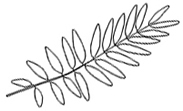Honey locust
Févier épineux
Gleditsia triacanthos L.Caesalpinaceae (cassia family)Origin: Eastern North America (native in Ontario)

Origin: Eastern North America (native in Ontario)

Honey locust is a medium-sized tree with angular branches and light, feathery foliage.
Read more about Tree, Bark, TwigsLeaves are pinnately compound (some doubly pinnate) with 18 - 30 small leaflets. There is no leaflet at the tip.
Read more about LeavesFlowers are greenish-white and very small, borne in inconspicuous clusters.
Read more about FlowersHoney locust is a medium-sized tree with angular branches, a broad, flat-topped crown, and light, feathery foliage. It can grow up to 30 m (98').
Leaves are pinnately compound with 18 - 30 oval leaflets on a central stalk 15 - 30 cm (6" - 12") long. There is no leaflet at the tip. Leaflets are 2.5 - 5 cm (1" - 2") long.
Leaves on new long shoots are arranged alternately on the branch as are clusters of early leaves on short shoots.
Flowers are borne in clusters, with separate male and female flowers sometimes on separate trees. The dense male flower clusters are about 5 - 7 cm (2" - 2 3/4") long.
Female flower clusters, consisting of only a few inconspicuous, loosely grouped flowers, are about 7 - 9 cm (2 3/4" - 3 1/2") long.
Fruits are flattened, twisted seed pods, about 15 - 40 cm (6" - 15 3/4") long, and pale-green until mature.
Distribution
Wild honey locust is rare in Canada, occurring only in extreme southwestern Ontario. However, honey locust is cultivated well beyond this range and has become naturalized in certain locales. Honey locust may have been planted by early settlers to attract bees to make honey. Its hardiness and tolerance of drought make it a resilient urban tree.
Derivation of names
The genus name, Gleditsia, commemorates the German botanist Johann Gottlieb Gleditsch (1714-1786), who was a professor and the director of the Berlin Botanic Garden. The species name triacanthos means three-horned, in reference to the wild trees' often three-pronged thorns. Triacanthos is derived from the Greek words treis, meaning three, and akantha, meaning spine. 'Honey' locust refers to a sweet substance that is found in the tree's seed pods. 'Locust' is thought to have been applied to honey locust and other pod-bearing trees of North America by early colonists, inspired by the story of John the Baptist, who survived in the wilderness by eating the fruit of pod-bearing carob or locust trees.
Human use
The wood of honey locust is fairly brittle but has been used for making fence posts and furniture. The thorns have been used to make nails and pins, and according to legend, Confederate soldiers in the US Civil War used them to pin their damaged uniforms. The sweet substance from the pods has been used in beer brewing, and was eaten by indigenous North Americans.
Wildlife value
The seeds and pods are also a source of food for various animals and birds, including cattle, white-tailed deer, and squirrels. Bees are attracted to the fragrant flowers.
Honey locust's place in Toronto's urban Forest
Honey locust is now a commonly planted tree on Toronto's streets, and can be seen especially in newer neighbourhoods. Honey locust is a preferred urban tree because it is highly tolerant of salt pollution and drought.
Landscape value and potential for home use
Honey locust is valued as a landscape tree for its open crown and the light shade that it casts. It grows best on rich, moist soils in sunny sites but will likely not reach its maximum height in most urban conditions. Gleditsia triacanthos var. inermis is a naturally occurring thornless variety (inermis = unarmed) that has been cultivated for urban planting, and bred for other visual characteristics, such as growth habit and leaf colour.
Pests and diseases: Honey locust is usually not vulnerable to fatal pests or diseases, but there are many damaging agents that may affect it. Most of the problems associated with honey locust result from insects feeding on the leaves.
This tree is available for planting through the City of Toronto's street tree program and LEAF's backyard tree program .
Links to maps at Canadian Tree Tours: